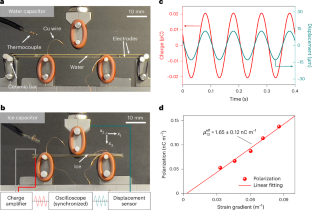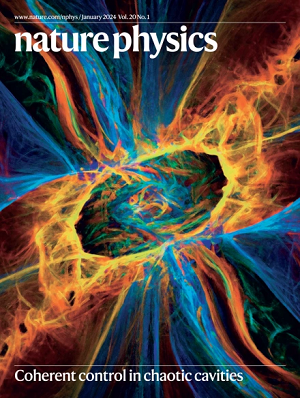水冰的柔性电性和表面铁电性
IF 18.4
1区 物理与天体物理
Q1 PHYSICS, MULTIDISCIPLINARY
引用次数: 0
摘要
在环境压力下的冰冻水——普通的冰,也被称为六边形Ih冰——是一种非极性物质,尽管单个水分子是极性的。因此,冰不具有压电性,不能在压力下发电。然而,原则上它可以在弯曲下发电,因为极化和应变梯度之间的耦合(挠性电)总是被对称所允许的。在这里,我们测量了冰的挠性电,发现它与基准电陶瓷如TiO2和SrTiO3相当。此外,挠曲电测量对地表边界条件的敏感性揭示了在160 K左右的铁电相变局限在冰盖的近地表区域内。除了在寒冷地区原位制造的低成本传感器的潜在应用之外,这些发现对我们对涉及冰的自然现象的理解产生了深远的影响:我们对雷暴云中冰-霰碰撞产生的柔性电荷密度的计算与在此类事件中转移的实验电荷进行了比较,这表明冰柔性电可能参与了闪电的产生。本文章由计算机程序翻译,如有差异,请以英文原文为准。


Flexoelectricity and surface ferroelectricity of water ice
Frozen water at ambient pressure—common ice, also known as hexagonal Ih ice—is a non-polar material, even though individual water molecules are polar. Consequently, ice is not piezoelectric and cannot generate electricity under pressure. However, it may in principle generate electricity under bending, because the coupling between polarization and strain gradient (flexoelectricity) is always allowed by symmetry. Here we measure the flexoelectricity of ice and find it to be comparable to that of benchmark electroceramics such as TiO2 and SrTiO3. Moreover, the sensitivity of flexoelectric measurements to surface boundary conditions has revealed a ferroelectric phase transition around 160 K confined within the near-surface region of the ice slabs. Beyond potential applications in low-cost transducers made in situ in cold locations, these findings have profound consequences for our understanding of natural phenomena involving ice: our calculations of the flexoelectric charge density generated in ice–graupel collisions inside thunderstorm clouds compare favourably to the experimental charge transferred in such events, suggesting a possible participation of ice flexoelectricity in the generation of lightning. Ice is not piezoelectric, despite the polarity of water molecules, but bending ice may produce electricity. This has now been experimentally demonstrated, with a flexoelectric coefficient comparable to that of common ceramic materials.
求助全文
通过发布文献求助,成功后即可免费获取论文全文。
去求助
来源期刊

Nature Physics
物理-物理:综合
CiteScore
30.40
自引率
2.00%
发文量
349
审稿时长
4-8 weeks
期刊介绍:
Nature Physics is dedicated to publishing top-tier original research in physics with a fair and rigorous review process. It provides high visibility and access to a broad readership, maintaining high standards in copy editing and production, ensuring rapid publication, and maintaining independence from academic societies and other vested interests.
The journal presents two main research paper formats: Letters and Articles. Alongside primary research, Nature Physics serves as a central source for valuable information within the physics community through Review Articles, News & Views, Research Highlights covering crucial developments across the physics literature, Commentaries, Book Reviews, and Correspondence.
 求助内容:
求助内容: 应助结果提醒方式:
应助结果提醒方式:


